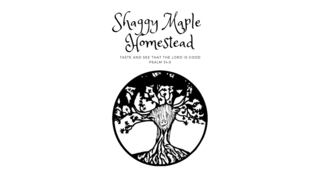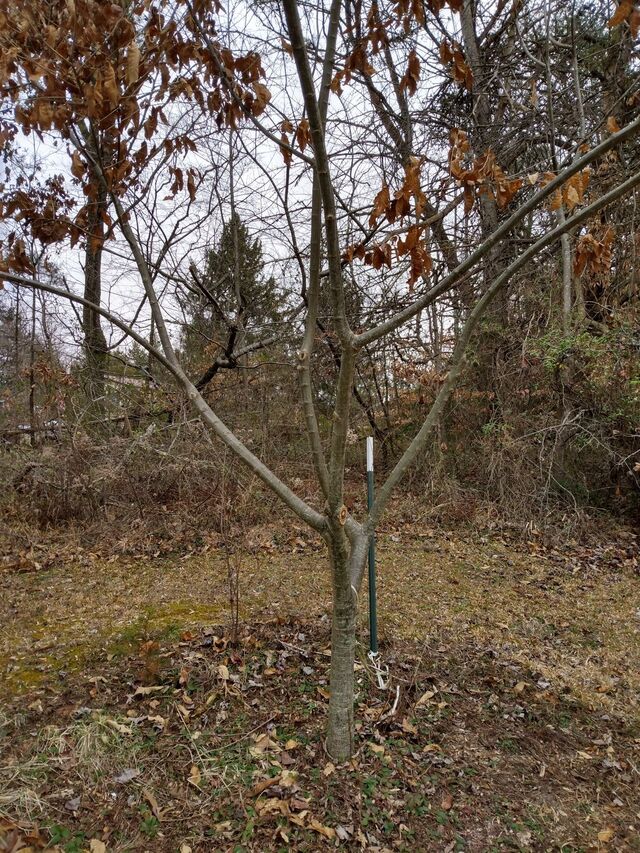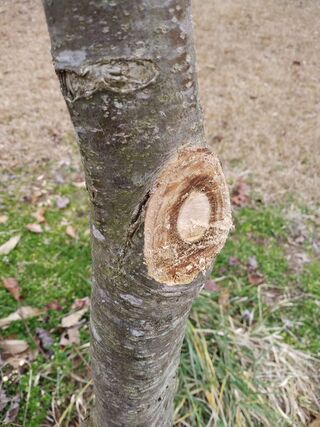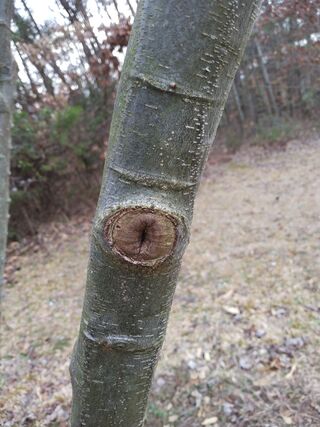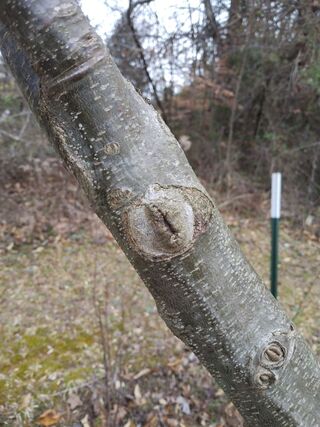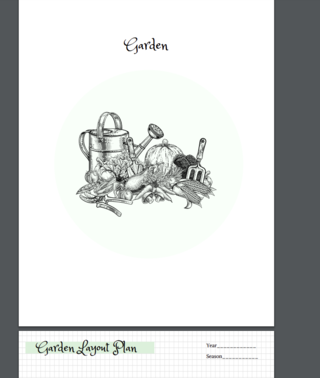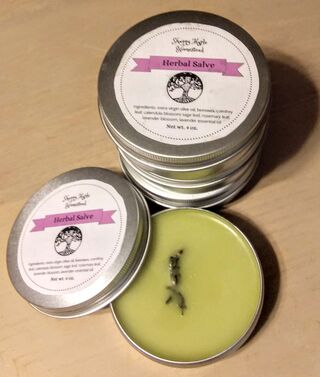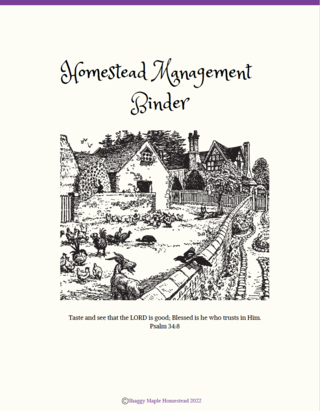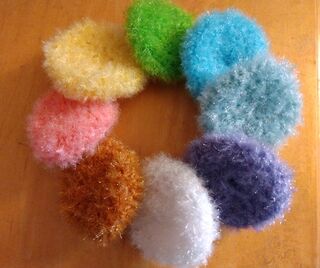Pruning Chestnut Trees in Dormancy
Saturday, February 12, 2022
When my husband and I first purchased our property 5 years ago, it was a lot of rolling open grass- the kind of lawn that suburbians would kill for. I looked at it and said, "Very nice, I'll change it all though- I can't eat manicured lawn." So the first thing we did to convert the property to "homestead" was to plant a ton of fruit and nut trees.
My husband is highly skilled in digging into the reasons for doing something, especially if that something is going to cost him time, money, and labor. He began researching nut alternatives to grain/flours as a way to support our allergy-restricted diets (though he himself has no food allergies- what a loving man.) He eventually fell in love with the idea of native chestnuts. Through our research, we learned that chestnuts are more carb than fat, like most other nuts, and that chestnut blight brought in on imported Asian chestnuts in the early 1900s destroyed the majority of the American chestnuts, and drove the once predominant tree into extinction. So what was our alternative? Well, since we're focused on breed and species conservation, my husband decided on Dunstan Chestnuts from Chestnut Hill Tree Farm, which are a hybrid of a single American Chestnut which was miraculously unaffected by the blight, and three varieties of USDA allowed Chinese chestnut varieties. Here is a brief history of the tree!
"The Dunstan Chestnut
Castanea dentata X mollissima
In the early 1950s, James Carpentar of Salem, Ohio, discovered a large living American chestnut in a grove of dead and dying trees. A member of the Northern Nut Growers Association, Carpentar was very impressed with the tree as it showed no evidence of blight infection. Over the next several years, he inoculated the tree with active blight spores and mycelia, but failed to induce any infection in the tree.
Carpentar sent budwood to Dr. Robert T. Dunstan, a fellow member of NNGA and well-known plant breeder in Greensboro, N.C. Dunstan grafted the scions onto chestnut rootstock and the trees grew well. He cross-pollinated the American grafts with a mixture of 3 superior USDA released Chinese chestnut selections: “Kuling,” “Meiling,” and “Nanking.”
In 1962, seedling trees from the first cross began to bear. Selecting the individuals with the most hybrid characteristics, Dr. Dunstan crossed them back to both the American and Chinese parent trees. The resulting second generation was moved to Alachua in north central Florida, on our nursery property, where the trees have been growing and bearing every year for almost 50 years! These hybrid trees have been grown throughout much of the eastern United states, and almost none have ever died from the blight.
Starting in 1984 we planted a grove of 500 trees using both grafts from the best of the second generation trees and a third generation of seedling Dunstans, many of which are now over 50' tall and 16-20? in diameter." [1]
We were delighted with the trees when they arrived to the homestead and after a period of sun mapping, determined that our south-facing slope would become our new fruit and nut orchard. We planted 3 Dunstan chestnuts in 2016, and they produced their first ever tiny harvest of nuts in the autumn of 2020.
2021 saw a late frost that killed off the catkins in the spring, and so we did not see a yield at all last year- 2021 was a rough year for most of our crops, in fact. However, this year is looking as if it may shape up to produce more nuts than we have seen to date! and part of that is due to our annual pruning practices.
Chestnuts are to be pruned in dormancy. I do not prune in the "textbook" fashion, as I have learned both through the wisdom of Paul Gautschi as well as my own experience that the textbook method of pruning yields nothing but dead wood, and sucker branches, which is another way of saying "work for me." Instead, I cut to the collar of the branch and utilize the Chinese method of pruning in such a way as to open up the tree for maximum air flow and production space. The saying goes that there should be enough space to toss a cat through the branches without it hitting any. I haven't tested this with a cat, but I can see the wisdom in allowing maximum air circulation to prevent mildew or blight from striking, especially here in our humid East Tennessee climate, which is technically a temperate rainforest!
In cutting to the collar, the cuts heal over completely, no suckers form at the sight of the cut, and there are no issues with water runoff causing rot in the tree. It is almost heartbreaking to me to see trees at nurseries that have densely crowded branches hacked off like poorly executed field amputations that leave them looking haggard and nearly dead. Those poor trees! Should you ever decide to book a tour to our back to Eden gardens, I make it a point of showing my trees and how they have been pruned- Once you see it done this way, you will never again return to "textbook."
The key to successful pruning in dormancy is four-fold:
1) Wait until the coldest part of your winter season to ensure the tree is in fact dormant, but not too close to spring as the tree will be waking from dormancy and cutting green wood increases risk of infection and jagged cuts.
2) Invest in quality tools. While I haven't gone all out and invested in Felco pruners, I got a step below and keep them extra sharp. Between my pruning shears and a quality pruning saw, I've got all I need to make all the necessary cuts look clean and tidy.
3.) Prune for openness first, growth second, symmetry last. Your cuts should be done in such a way that people passing your tree should think it just naturally grows that way. Begin by cutting any branches or limbs that are crossing through the center of the tree. Then move on to any branches that are growing at greater than or less than a 45 degree angle. Too acute an angle leads to crowding, too obtuse an angle can lead to limb breakage with wind, storms, or animals applying pressure to the branches.
4.) Take no more than one third of the total new growth in one pruning session. If your trees are badly unkempt, resist the temptation to hack and slash all at once. It took more than one year to become untidy, it will take more than one year to get it back under control. And whatever you do, never, ever, EVER use loppers for pruning-- they are far too indelicate a tool and were not meant for the job of precision pruning.
In the same way our Heavenly Father divinely gifted us with the illustration of wisdom and truth in pruning our trees, so He also prunes us spiritually to remove "dead wood," aspects of our lives that do not serve His purposes, or branches that do not produce fruit. "Every branch in Me that does not produce fruit He removes, and He prunes every branch that produces fruit so that it will produce more fruit." (John 15:2)
It seems counter intuitive to cut off branches to yield more fruit. But in practical spiritual application, it makes complete sense; In getting rid of excess, damaged, or useless things, we are able as people to focus in on the things and priorities God has given us and we can experience depth and growth to a degree we could not have had we been distracted by the excess. In the same way, our trees, free from dead or damaged branches that congest and choke the life and production out of them, they can focus their nutrients and growth into producing healthy mature nuts for our family. God is good! and doing things His way always yields much.
Sources/References:
For more information on pruning trees, I recommend looking up Paul Gautschi's pruning tutorial videos on Thatnub's YouTube channel: https://youtu.be/ThPNNbLzHgo
[1] Dunstan Chestnut history – chestnut hill nursery. Since 1991 Chestnut Hill Nursery. (n.d.). Retrieved February 12, 2022, from https://chestnuthilltreefarm.com/learning-center/dunstan-chestnut-history-2/
